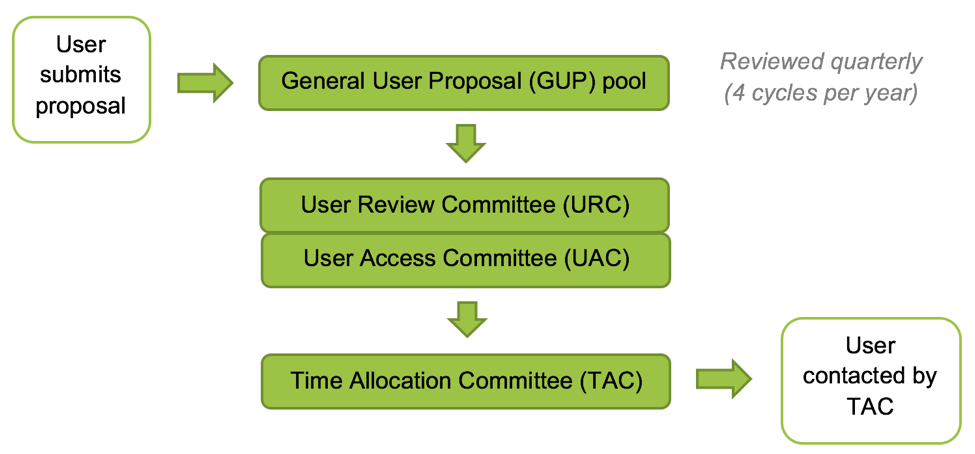Frequently asked questions (FAQ)
When are the proposal cycles and deadlines?
There are up to 4 cycles a year. Each calendar quarter is a cycle. Applications initially will be accepted and scored on a rolling basis. Future deadlines and cut-offs will be posted on nccat.nysbc.org.
How do I submit a review?
Prospective users should submit a proposal through our web form (http://nccat.nysbc.org/reviewercentral/). Each review must be submitted separately.
I submitted a review do I receive a confirmation?
A confirmation should be sent upon receipt of your proposal.
I can’t get the review system to work, can I just email you my review?
If you cannot use the system to submit your review, then please email nccatuseroffice [at] nysbc.org and we will work out a solution.
How do I edit my review?
If you would like to revise your review please email nccatuseroffice [at] nysbc.org. Otherwise, you may contact the NCCAT manager or NCCAT traffic controller directly.
Are reviews confidential?
According to COPE guidelines (http://publicationethics.org/files/Ethical_Guidelines_For_Peer_Reviewers_2.pdf) any information received for review must be treated as confidential documents.
Since peer review is confidential, reviewers must not share the review or information about the review with anyone without the agreement of the editors and authors involved. This applies both during and after the allocation process.
Is my identity confidential?
The members of the URC may be posted in the future, but at this time both who the reviewers are and who reviews each proposal is kept confidential.
URC, UAC, TAC, what is this alphabet soup?

Proposals are submitted to NCCAT and NCCAT staff sends them out to the User Review Committee (URC) for peer review. Our goal is to keep the overhead as low as possible and to have speedy reviews. To accomplish this we have each proposal reviewed by multiple URC members. The reviews of the URC are normalized by the User Access Committee (UAC) and forwarded to NCCAT staff for time allocation. The Time Allocation Committee (TAC) will then work on allocating time and scheduling users for the upcoming cycle.
A user has a Krios or access to one, can they still use NCCAT?
The user is eligible to use NCCAT. We score on 5 different categories. Having a Krios that they can easily access would affect their geographical demographics or need category, but there are multiple factors in the process.
What happens if the user has significant access to cryoEM instrumentation at their home institution?
That would mean they may score poorly on their geographical demographics or need category. However, if all the applicants in the pool have equivalent access then the other categories will become differentiating factors.
Can my collaborator apply? Am I eligible to use NCCAT?
Everyone is welcome to apply. NCCAT is committed to an open and transparent process. If there is a conflict of interest please let us know. Our mission is to provide nationwide access to cryoEM and promote cross-training of the technique.
I’m apart of the URC, does that mean I can apply for NCCAT time?
Yes. You are eligible.
I started the review process, but what should I do if I can’t complete it?
We encourage a timely and efficient review process. If you cannot complete the process please inform the NCCAT manager and/or NCCAT traffic controller as soon as possible. We may need to send the proposals out to additional reviewers to ensure proposals are scored and awarded (if applicable) as soon as possible.
All these proposals are really strong or really poor, did you prescreen these applications?
NCCAT does not read or edit the content of the applications except to ensure there are no missing pieces of information. We do not prescreen the applications and they are randomly assigned proposals in each review packet. The webform has a template to present a standard typeset application to you, typically in chronological order with respect to the submission date. Our goal is to ensure that we do not bias the review process.
How many reviewers do you have review each application?
We do our best to ask at least 3 URC members to review each application. The range has been 2-5 reviews per application, but the mean for 2022 is 2.65 per application.
How many URC members are there?
In 2018 we had 10 people make up our URC. In 2019 we have asked 15 more people to join the URC. At the beginning of 2019, there were 18 active URC members with a couple more ready to be active by Q2 2019. By mid-2019 we had 29 active URC members. At the end of 2019 we have 38 URC members. For review cycle 4 of 2019 we utilized 1/3 of our committee to ensure each proposal had multiple reviews. During the COVID-19 pandemic, we grew our URC to reduce reviewer burden and starting in 2021 we had over 65 members with no more than a dozen members actively reviewing per cycle. Entering 2022 we had our first cohort of reviews self-elect to move to “reserve” status with a URC of 42 active reviewers and 26 reserve reviewers for a total of 88 URC members. In 2023, each cycle we made a call to add more URC reviewers to keep review burden as low as possible.
I have a larger teaching load this semester… have been asked to serve on 5 more committees… am on sabbatical… etc… May I receive fewer applications? or resign from the URC?
We understand and appreciate that you have been apart of the URC. We hope that you can stay with us and will first try to either limit the review packets or how many times a year we call upon you to review. For new URC members we send out a survey to better understand the capacity of each URC member. If your capacity to review has changed you may let us know and we will update our records.
